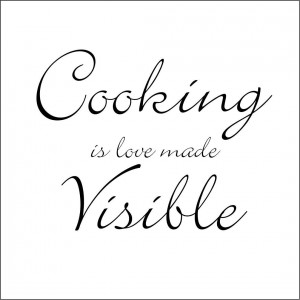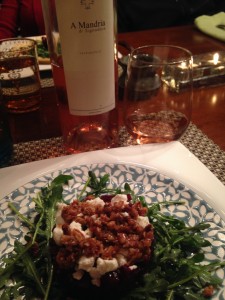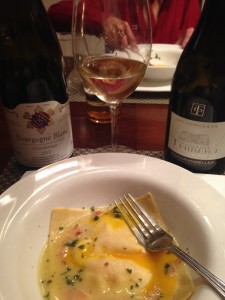 “Cooking is LOVE made visible…” – Anonymous
“Cooking is LOVE made visible…” – Anonymous
“Wine to me is passion. It’s family and friends. It’s warmth of heart and generosity of spirit.” – Robert Mondavi
I grew up with the understanding that food tastes better when made with love. When I was sick in bed and my taste buds were shot, my mother’s homemade soup would always make me feel better. And it was always delicious. When my daughters cook my breakfast on Mother’s day, I find myself going for seconds… sometimes thirds. Again, delicious. And of course, when my husband offers to make dinner for me on those infrequent but extremely well thought out occasions, I find myself savoring every bite as though it would be my last.
Love is one of those invisible ingredients that is necessary to every dish you create. After all, a recipe on paper (or online!) has no SOUL… It is the cook’s responsibility to bring soul to the recipe!
Inspired by LOVE and all things red, pink, and festive, we created a memorable dinner menu paired with some fabulous wines this year for Valentine’s Day. Our dear friends joined us as we paraded through courses of decadence. Here’s what we noshed and sipped on!
 Charlot Tanneux Champagne Brut Cuvee Micheline 2008 – Suggested by colleagues and clients alike, I decided to bring home a bottle of this beauty for our special evening. This is a super sultry bottle of bubbles. Kudos to winemaker Vincent Charlot who clearly knows that the foundation of a stunning champagne is first and foremost, is to be a stunning WINE. This bubbly is rich, with a confusing but delicious combination of crisp and cooked apples, white fruits, flowery aromatics, and a seductive sweetness that is perfectly balanced. The perfect start to the evening!
Charlot Tanneux Champagne Brut Cuvee Micheline 2008 – Suggested by colleagues and clients alike, I decided to bring home a bottle of this beauty for our special evening. This is a super sultry bottle of bubbles. Kudos to winemaker Vincent Charlot who clearly knows that the foundation of a stunning champagne is first and foremost, is to be a stunning WINE. This bubbly is rich, with a confusing but delicious combination of crisp and cooked apples, white fruits, flowery aromatics, and a seductive sweetness that is perfectly balanced. The perfect start to the evening!
Beet Tartare with Chevre and Maple Chili Pecans paired with A. Mandria Patrimonio Rose 2014 – We topped a composed salad of arugula, beets dressed in balsamic, and chevre  with maple-chili glazed pecans. This dish begged for a rose to be paired with it, and I couldn’t imagine a better one than this Corsican gem. Rose petals, strawberries, and citrus on the nose… Melon and stone fruits on the palate. It was a perfect match! Click here for the Beet Tartare recipe…
 Egg Yolk Ravioli with Sage and Pancetta paired with Domaine Thibert Pouilly Vinzelles Les Longeayes 2012 and Domaine Bzikot Bourgogne Blanc 2013 – Velvet. That’s the word that came to mind when I tasted the perfectly runny yolk that oozed out of our ricotta and egg filled homemade raviolis into a sauce of butter, stock, sage, and pancetta. This called for a wine with some acid to pair with it. Some of my favorite producers of white Burgundy came to mind… I actually appreciated both wines with the ravioli. The Vinzelles was a better match on paper due to the richness of the wine and the buttery-“velvety” style of the sauce but the acidity of the Bzikot really cut through the decadence of the sauce and made for a perfect match. Thanks to our dinner companions for bringing the Bzikot wine – it was so nice to taste 2 very different style of white Burg with this dish! Click here for the Egg Yolk Ravioli recipe…
Egg Yolk Ravioli with Sage and Pancetta paired with Domaine Thibert Pouilly Vinzelles Les Longeayes 2012 and Domaine Bzikot Bourgogne Blanc 2013 – Velvet. That’s the word that came to mind when I tasted the perfectly runny yolk that oozed out of our ricotta and egg filled homemade raviolis into a sauce of butter, stock, sage, and pancetta. This called for a wine with some acid to pair with it. Some of my favorite producers of white Burgundy came to mind… I actually appreciated both wines with the ravioli. The Vinzelles was a better match on paper due to the richness of the wine and the buttery-“velvety” style of the sauce but the acidity of the Bzikot really cut through the decadence of the sauce and made for a perfect match. Thanks to our dinner companions for bringing the Bzikot wine – it was so nice to taste 2 very different style of white Burg with this dish! Click here for the Egg Yolk Ravioli recipe…
Braised Short Ribs with Swiss Chard and Potatoes paired with Chateau Rayas Ch du Fonsalette 2000 and Rovellotti Ghemme Chioso dei Pomi 2008 – OMG. Loved this short rib preparation. After it braised, it finished off in a 400 degree oven to almost “crisp up.” So the meat had a bite to it on the outside and was super tender once we cut into it. The velvety sauce along with the swiss chard were a great foundation for some complex and structured wines. We had two fabulous bottles. We decanted the Ghemme for almost 2 hours, and it evolved into a smooth and elegant pairing with luscious dark berry tones, aromatic violets, and structure that softened into great complexity. SO ethereal. Such a great pairing. However, I think I practically went into a trance when I took a sip of the Rayas. This 2000 vintage of juice from the Fonsalette property is labeled as Cotes du Rhone – but make no mistake… it IS a VERY serious wine! A lovely Rhone blend of red varietals, the wine is creamy and textured, game-y with lots of garrigue, some herbal tones and even a little bit of licorice. In my opinion, this wine was perfect with the short ribs and accompaniments. Click here for the short rib recipe!
 Simply stated, the inspiration for the meal came form love, exuded love, and was served to those I love. Made with Love <3
Simply stated, the inspiration for the meal came form love, exuded love, and was served to those I love. Made with Love <3
